
Prepare IAS Coaching
Current Affairs

Title : THE PAIKA REBELLION
Date : Dec 04, 2021
Description :
GS I
Topic à Modern Indian History
- Current Relevence:
- The Paika Bidroha (Paika Rebellion) of 1817 in Odisha, generally known as the first struggle of independence, shook the foundations of British control in the eastern part of India for a brief period in 1857.
- The year 2017 celebrated the 100th anniversary of one of the largest revolts in eastern India's history, which was put down with considerable severity.
- Who were the Paikas:
- Paikas were essentially the Gajapati kings of Odisha's peasant militias, who provided military service to the monarch during times of war while farming during times of peace.
- A Brief Background of the revolt:
- Odisha was ruled by the Marathas until 1803, when they were forced to yield much of their territory to the British East India Company following the second Anglo-Maratha War.
- Following the establishment of British administration in Odisha, the Paikas were subjected to repression.
- They lost their usual social status, and their lands were taken away from them.
- The Paikas were heavily mistreated by revenue collectors under the British, in addition to losing their properties.
- About the Rebellion:
- In March 1817, the Rebellion Paikas, led by Baxi Jagabandhu, the hereditary head of the Gajapati King of Khurda (a kingdom near Puri), rose in rebellion, gaining backing from tribals and other parts of society.
- During their march to Khurda, the Paikas destroyed British symbols of power, setting fire to police stations, administrative offices, and the treasury.
- Rajas, zamindars, village chiefs, and common peasants all backed the Paikas. The insurgency swiftly expanded to other sections of the province.
- The British were caught aback and attempted to reclaim lost ground, but were met with heavy resistance from the rebellious Paikas. The British, on the other hand, eventually vanquished the Paikas.
- For several years, the Paikas retreated into the dense woods of Odisha and waged guerrilla warfare. Bakshi Jagabandhu, the Paika leader, surrendered to the British in 1825 after a series of losses and lived as a prisoner in Cuttack till his death in 1829.
- Source à The Hindu à 03/12/21 à Page Number 8
